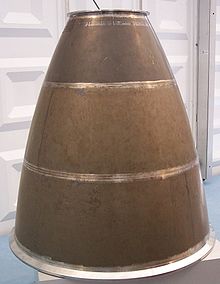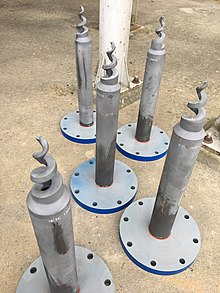| This article needs additional citations for verification. Please help improve this article by adding citations to reliable sources. Unsourced material may be challenged and removed. Find sources: "Nozzle" – news · newspapers · books · scholar · JSTOR (March 2009) (Learn how and when to remove this message) |

 Rotator style pivot applicator sprinkler
Rotator style pivot applicator sprinkler End Gun style pivot applicator sprinkler
End Gun style pivot applicator sprinkler
A nozzle is a device designed to control the direction or characteristics of a fluid flow (specially to increase velocity) as it exits (or enters) an enclosed chamber or pipe.
A nozzle is often a pipe or tube of varying cross sectional area, and it can be used to direct or modify the flow of a fluid (liquid or gas). Nozzles are frequently used to control the rate of flow, speed, direction, mass, shape, and/or the pressure of the stream that emerges from them. In a nozzle, the velocity of fluid increases at the expense of its pressure energy.
Types
Jet
A gas jet, fluid jet, or hydro jet is a nozzle intended to eject gas or fluid in a coherent stream into a surrounding medium. Gas jets are commonly found in gas stoves, ovens, or barbecues. Gas jets were commonly used for light before the development of electric light. Other types of fluid jets are found in carburetors, where smooth calibrated orifices are used to regulate the flow of fuel into an engine, and in jacuzzis or spas.
Another specialized jet is the laminar jet. This is a water jet that contains devices to smooth out the pressure and flow, and gives laminar flow, as its name suggests. This gives better results for fountains.
The foam jet is another type of jet which uses foam instead of a gas or fluid.
Nozzles used for feeding hot blast into a blast furnace or forge are called tuyeres.
Jet nozzles are also used in large rooms where the distribution of air via ceiling diffusers is not possible or not practical. Diffusers that uses jet nozzles are called jet diffuser where it will be arranged in the side wall areas in order to distribute air. When the temperature difference between the supply air and the room air changes, the supply air stream is deflected upwards, to supply warm air, or downwards, to supply cold air.
High velocity

Frequently, the goal of a nozzle is to increase the kinetic energy of the flowing medium at the expense of its pressure and internal energy.
Nozzles can be described as convergent (narrowing down from a wide diameter to a smaller diameter in the direction of the flow) or divergent (expanding from a smaller diameter to a larger one). A de Laval nozzle has a convergent section followed by a divergent section and is often called a convergent-divergent (CD) nozzle ("con-di nozzle").
Convergent nozzles accelerate subsonic fluids. If the nozzle pressure ratio is high enough, then the flow will reach sonic velocity at the narrowest point (i.e. the nozzle throat). In this situation, the nozzle is said to be choked.
Increasing the nozzle pressure ratio further will not increase the throat Mach number above one. Downstream (i.e. external to the nozzle) the flow is free to expand to supersonic velocities; however, Mach 1 can be a very high speed for a hot gas because the speed of sound varies as the square root of absolute temperature. This fact is used extensively in rocketry where hypersonic flows are required and where propellant mixtures are deliberately chosen to further increase the sonic speed.
Divergent nozzles slow fluids if the flow is subsonic, but they accelerate sonic or supersonic fluids.
Convergent-divergent nozzles can therefore accelerate fluids that have choked in the convergent section to supersonic speeds. This CD process is more efficient than allowing a convergent nozzle to expand supersonically externally. The shape of the divergent section also ensures that the direction of the escaping gases is directly backwards, as any sideways component would not contribute to thrust.
Propelling
Main article: Propelling nozzleA jet exhaust produces thrust from the energy obtained from burning fuel. The hot gas is at a higher pressure than the outside air and escapes from the engine through a propelling nozzle, which increases the speed of the gas.
Exhaust speed needs to be faster than the aircraft speed in order to produce thrust but an excessive speed difference wastes fuel (poor propulsive efficiency). Jet engines for subsonic flight use convergent nozzles with a sonic exit velocity. Engines for supersonic flight, such as used for fighters and SST aircraft (e.g. Concorde) achieve the high exhaust speeds necessary for supersonic flight by using a divergent extension to the convergent engine nozzle which accelerates the exhaust to supersonic speeds.

Rocket motors maximise thrust and exhaust velocity by using convergent-divergent nozzles with very large area ratios and therefore extremely high pressure ratios. Mass flow is at a premium because all the propulsive mass is carried with vehicle, and very high exhaust speeds are desirable.
Magnetic
Main article: Magnetic nozzleMagnetic nozzles have also been proposed for some types of propulsion, such as VASIMR, in which the flow of plasma is directed by magnetic fields instead of walls made of solid matter.
Spray
Main article: Spray nozzleMany nozzles produce a very fine spray of liquids.
- Atomizer nozzles are used for spray painting, perfumes, carburetors for internal combustion engines, spray on deodorants, antiperspirants and many other similar uses.
- Air-aspirating nozzles use an opening in the cone shaped nozzle to inject air into a stream of water based foam (CAFS/AFFF/FFFP) to make the concentrate "foam up". Most commonly found on foam extinguishers and foam handlines.
- Swirl nozzles inject the liquid in tangentially, and it spirals into the center and then exits through the central hole. Due to the vortexing this causes the spray to come out in a cone shape.
Vacuum
Vacuum cleaner nozzles come in several different shapes. Vacuum nozzles are used in vacuum cleaners.
Shaping
Some nozzles are shaped to produce a stream that is of a particular shape. For example, extrusion molding is a way of producing lengths of metals or plastics or other materials with a particular cross-section. This nozzle is typically referred to as a die.
See also
References
- Jet nozzles Type DUK (PDF). TROX GmbH. December 2006. Archived from the original (PDF) on 15 October 2013. Retrieved 15 October 2013.
- Saravanamuttoo, H. I. H.; Rogers, G. F. C.; Cohen, H. (2001) . Gas Turbine Theory (PDF) (5th ed.). Pearson Education. p. 108. ISBN 978-81-7758-902-3.
External links
- "Nozzle design (converging/diverging - CD nozzle)". NASA. Archived from the original on 20 March 2009. Retrieved 19 January 2009.